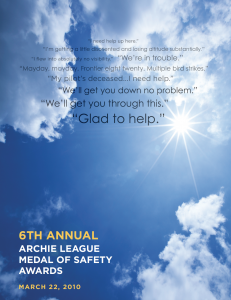
2010 – Winners of the 6th Annual Archie League Medal of Safety Awards, honored on March 22, 2010 at Disney’s Coronado Springs Resort in Orlando, Fla.:
Alaskan Region: Richard Todd Lamb, Anchorage Center, and Mike Evans, Fairbanks Flight Service Station
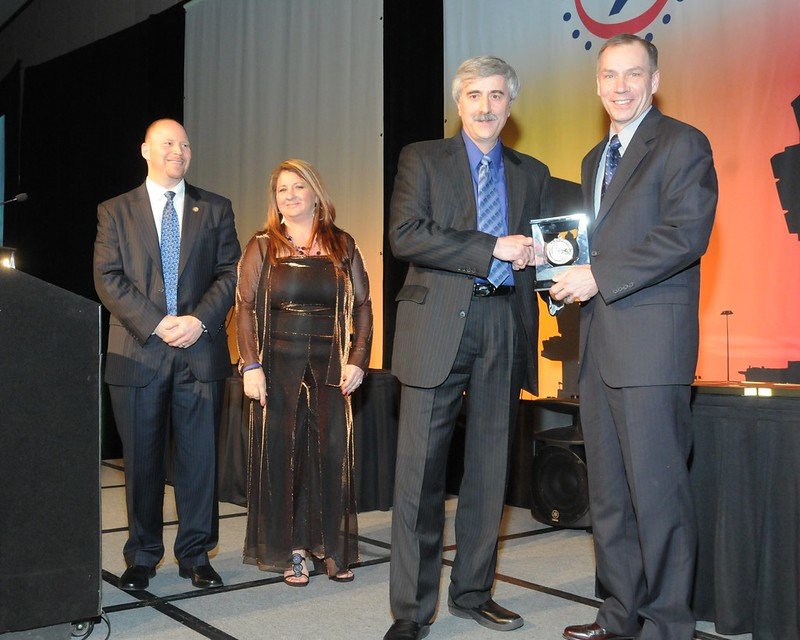
With thorough coordination and prioritization of duties, Alaskan members Todd Lamb and Michael Evans took control of an emergency situation on the afternoon of Dec. 20, 2009, to ensure a safe landing for not just one aircraft, but for two.
Fairbanks Automated Flight Service Station (AFSS) specialist Mike Evans was in the middle of assisting Rick Schikora, pilot of N3486C who had declared smoke in the cockpit of his Cessna C170B, when Todd Lamb took over Sector 15/16 at Anchorage Center.
Lamb: Do you think I can help him or what’s the situation?
Evans: He’s gonna have to land here pretty soon… We better get him on radar contact, for if we lose radar contact we’ll know where he’s at.
With no direction finding equipment in the area, Evans quickly used his ATC knowledge and experience to choose the best option for the current situation and elected to hand him off to the facility with radar coverage in the area, Anchorage Center.
Faced with an aircraft now unable to establish consistent communication due to its low altitude, Lamb was forced to relay all information through N7516K, a nearby Piper Cub coincidentally piloted by a friend of the distressed pilot. Using his 18 years of controller experience, plus his own familiarity with a Cessna aircraft, Lamb was able to successfully assist Schikora in locating a narrow dirt trail that would offer the only safe landing surface within the area.
“I don’t have a transponder but I can go ahead and land next to him on Nome Creek Trail and see if I can help him,” N7516K offered eagerly in hopes of assisting his friend. Lamb, aware that Schikora had since brought his aircraft to a safe stop on Nome Creek Trail, now set in to assist this second aircraft in its effort to locate the downed plane’s position.
“Advise your intentions of position on this frequency; call for overhead aircraft because I won’t be able to hear you,” instructed Lamb. “Let us know that everything’s good otherwise we’re gonna send rescue.”
From the moment Lamb began work on Dec. 20 until the very end, he provided attentive, above and beyond assistance to the aircrafts involved. Beginning his shift with initiative, he asked another facility what he could do to help. While using all resources available, he made sure that other aircraft in the area were monitoring the situation through its entirety and, after a notified of a safe landing, followed up with numerous questions to the pilot of N7516K regarding any rescue assistance needed on the ground. Lamb took extra precautionary measures throughout the entirety of this situation – a situation in which he knew time was imperative as exposure to the extreme temperatures in the Alaskan area could rapidly become an issue had the pilot not be picked up.
The teamwork, attention to detail, and calmness under pressure displayed here by Lamb and Evans are true examples of what our ATC system is all about. Through their decisive actions, they collectively helped create a happy ending to what could have been a tragic story.
“I was just really fortunate,” Schikora told Fairbanks Daily News Miner last December. “So many things went right. I call it an early Christmas present.”
Lamb and Evans call it “just another day at work.”
VIDEO: View award presentation.
Read transcript of event highlights.
Central Region: Jessica Hermsdorfer, Kansas City Tower/TRACON
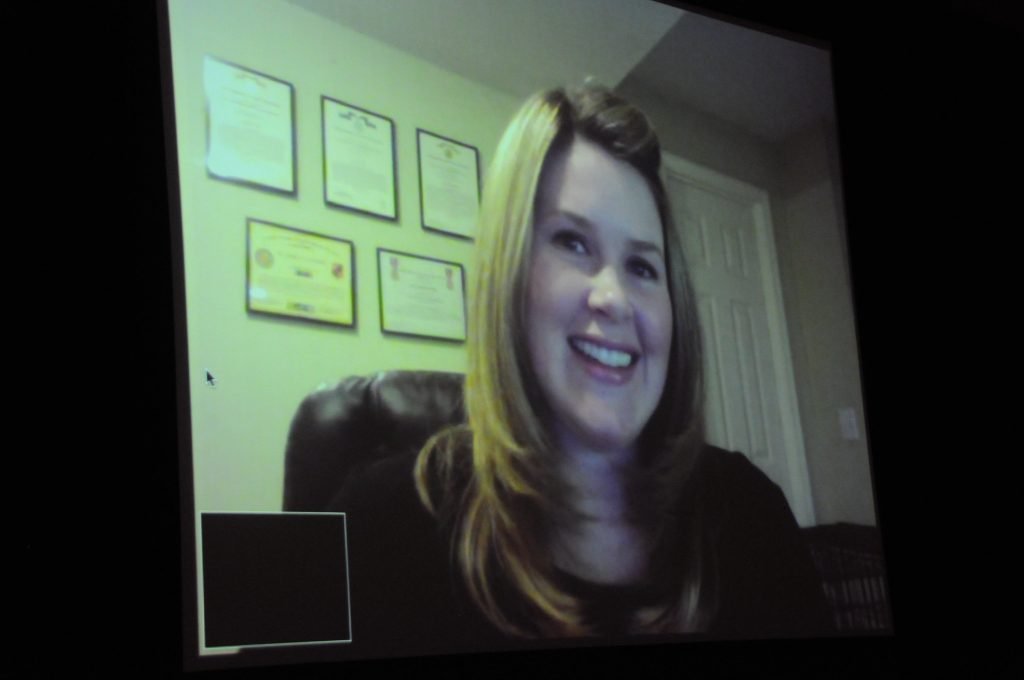
You already know about the “Miracle on the Hudson” event. But there was another terrifying collision between birds and an Airbus last year that didn’t get as much attention. While the aircraft involved – Frontier Airlines Flight 820, an Airbus 319 – maintained the use of one engine, the encounter was no less frightening to the 124 passengers onboard. And the safe airborne handling and emergency landing was also dramatic and memorable as an extraordinary example of professionalism both in the cockpit and in the control tower at Kansas City International Airport.
That’s where controller Jessica Hermsdorfer, an Air Force veteran and now a CPC at MCI for the past two years, was working departure radar all combined up in the tower cab in the early part of a Saturday evening.
Frontier 820 departed for Denver at approximately 7 p.m. local time and checked in on the departure frequency normally with Hermsdorfer.
Frontier 820: Departure, good evening, Frontier 820 is two point five, climbing one zero thousand.
Hermsdorfer: Frontier 820, Kansas City Departure, radar contact. Turn left heading two five zero, join the Salina transition. Climb and maintain one five thousand.
Hermsdorfer had two arrivals on the east downwind that she was also working when suddenly, Frontier 820’s climb was abruptly interrupted. It was a severe bird strike, occurring at about 4,000 feet.
“Mayday, mayday, Frontier eight twenty. Multiple bird strikes. Number two engine is having problems. We’re going to immediately return back to Kansas City.”
The aircraft suffered extensive damage. Both engines were struck and one caught fire, losing power. Hermsdorfer quickly but calmly sprang into action. “I turned the aircraft to a 180 degree heading for downwind,” she said. “I had another aircraft that was based for final approach, but then changed my mind and turned him out given the severity of the situation and I wanted to give Frontier a clean final.”
Hermsdorfer: Okay, Frontier eight twenty, expect Runway One Left and I’ll get you in as soon as possible. Expect the ILS.
Frontier 820: Thank you. Yeah, we’ve got severe damage number two engine, possible one engine as well.
Hermsdorfer: Okay, number two and number one. And then what else do you need?
Frontier 820: Uh, that’s it. Equipment standing by.
Hermsdorfer descended the aircraft to 3,000 feet and then went back and gave a pilot’s discretion descent “just in case they couldn’t hold altitude and wanted to wait to come down,” she said. She then told a GoJet flight that she was going to turn him out to get the emergency aircraft inbound first.
She gave the Frontier jet another instruction – a left turn heading 90 degrees. But there was nothing extraneous beyond that. Said Hermsdorfer, “I got all the information I could from the pilot without trying to overtask them, and Rob (Bratcher) who was working CIC rang out the crash phone.”
At this point, the aircraft was seven miles from the final approach fix. Hermsdorfer gave him a left turn heading 40 degrees, told the pilot to maintain 3,000 feet until established on the localizer and then cleared him for the ILS approach to Runway 1-Left. The aircraft landed safely shortly thereafter.
“She was calm and professional during the entire incident,” MCI Facility Representative Brian Barnes said. “She even had the awareness to ask the pilot if he would like to change frequencies over to the tower or just stay with her, and she would relay the landing clearance. Doing this showed her commitment to the safety of the flight crew and having the focus on not over-tasking the pilots.”
For her efforts, Hermsdorfer was given the FAA District Manager’s Award for Safety.
VIDEO: View the award presentation below.
Read the transcript of the event highlights.
Eastern Region: Louis Charles Ridley, Potomac TRACON
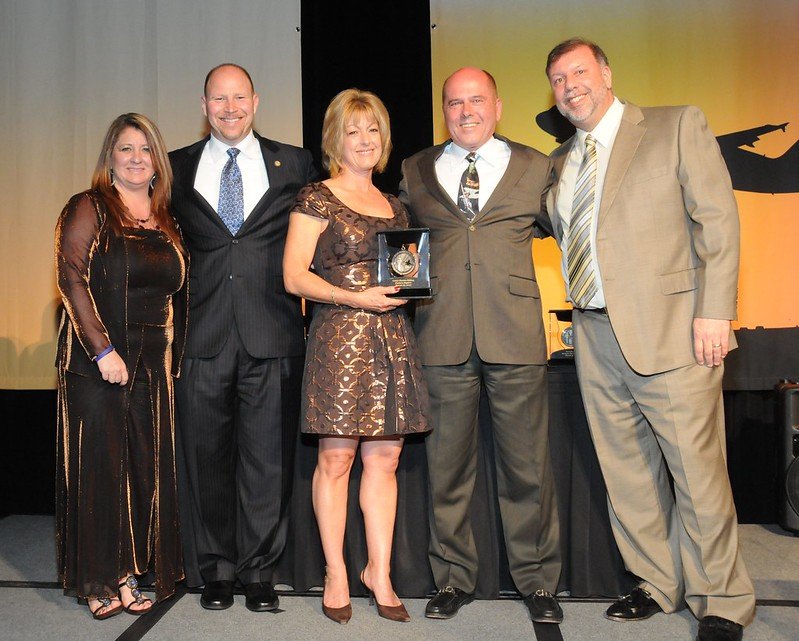
The pilot of the Velocity – tail number and call sign N129VA – who took to the skies above Northern Virginia after taking off from Manassas Regional Airport on July 5 last year probably is still quite thankful for his good fortune that afternoon. He received some of the very best personal care and safety service that a NATCA member can provide, courtesy of veteran Potomac TRACON (PCT) controller Louis Ridley.
Ridley, in addition to being a 22-year veteran controller who has been at PCT since 2004, is also an accomplished and highly skilled pilot as well as a flight instructor. “I grew up on an airport in upstate New York,” says Ridley. “My father taught me to fly before I could drive a car.” During Ridley’s first FAA assignment, at Columbia, S.C., TRACON, he started and ran his own pilot service business with 11 employees and also became involved in the airshow industry, with extensive experience at both Sun-N-Fun and Oshkosh until 2005.
So on this particular afternoon, Ridley proactively came to the aid of this pilot armed with an array of skills and talents and, above all, an extraordinary level of care and sense for what a pilot needs at a particularly challenging moment. Ridley keenly spotted this Velocity pilot, whom he knew just by interpreting the information on his radar scope was trying to land at Shenandoah Valley Regional Airport but was unable to do so because of an overcast layer. Ridley then dialed up the SHD Unicom frequency and listened for any aircraft talking. As soon as he could confirm a call sign, he reached out to the pilot to offer assistance.
Ridley: Velocity one two nine victor alpha, Potomac. You on the radio?
N129VA: Ah, Velocity one two nine victor alpha has you sir.
Ridley: Alright, do you require any assistance at this time?
N129VA: Uh, sir, if you know where there’s a hole for me to get down, I’d be a happy pappy.
Ridley: Okay, you’re not IFR capable or equipped at this time?
N129VA: That is correct. The pilot is not IFR capable.
Ridley then set to work to find a way down for the pilot. He discovered the aircraft had 45 minutes of fuel remaining and then, using his calm demeanor, reassured the pilot that he could get to an airport with acceptable weather conditions for a safe landing. He went the extra mile, using his own experience in the cockpit, to ask the pilot about his navigation and terrain-awareness equipment. Number one, it would help Ridley know what the aircraft was capable of. Number two, it might offer a measure of reassurance to the pilot to know he would be okay, keeping the mood light during this serious situation.
Ridley: I can sure talk you through an ILS if you’d like, or take you over to Culpepper where the land is flatter and take you in on a localizer approach, whatever you would like to do. I am a CF-Double I (CFII), I have six thousand hours, talked for over twelve hundred. I think I can talk you down if you want to do that.
The pilot said he was comfortable with going into Culpepper, so Ridley gave him a heading and pulled up the approach plate. He also recommended that the pilot utilize the autopilot and altitude hold functions. He also formally declared an emergency for the pilot and assigned him an altitude of 7,000. Soon, the aircraft would join the localizer and Ridley would track it to the airfield.
Then, Ridley made an amazing offer of assistance.
Ridley: November nine victor alpha. When you get to Culpepper, the airfield will be closed. I’m sure there’ll be some people around. If not, I’m based there with my airplane. I’ll send my wife down to make sure you get into a hangar and get some transportation so you don’t have to worry about any of that.
Soon after, the pilot was out of the clouds and on his way to a safe landing.
From Ridley, one final reassuring transmission:
Ridley: Nine victor alpha, radar service terminated. Go on over to Unicom, land, have yourself a nice cool drink.
VIDEO: View the award presentation below.
View a transcript of event highlights.
Great Lakes Region: Kristin Danninger, Madison Tower/TRACON
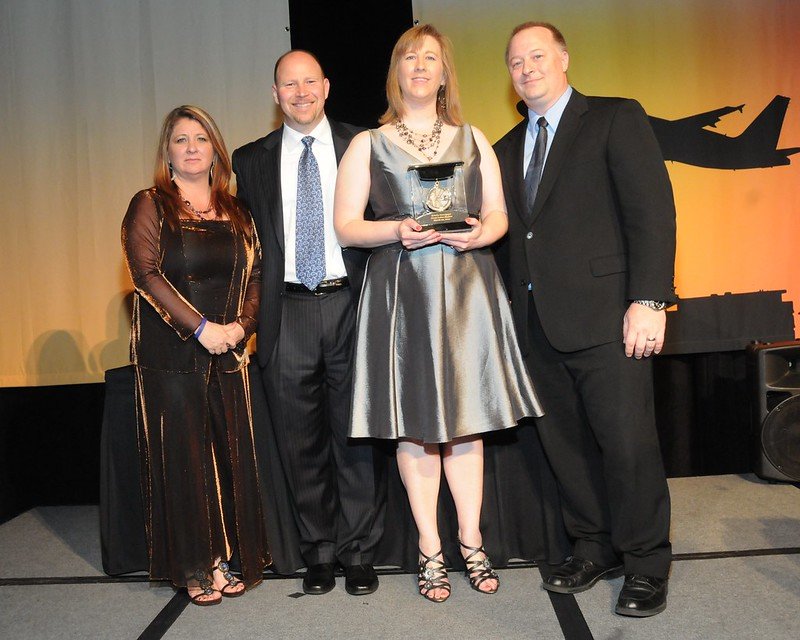
It was the first of the year and bad weather was moving in as 14-year veteran Kristin Danninger worked the radar approach position at Madison. A couple of VFR flights had already returned to MSN due to decreasing visibility when N6085M called in distress – a novice pilot stuck in the clouds near Baraboo Dells Airport.
N6085M: Madison Approach, Cessna six-zero-eight-five mike… flew into absolutely no visibility. I need your help getting outta here.
Danninger: November six-zero-eight five mike, can you climb VFR?
N6085M: I’m gonna climb… I can’t climb VFR. I’m in a zero visibility.
Knowing that a Cessna aircraft had flown VFR into Portage Airport a little while before, Danninger suggested the aircraft head eastbound.
“I still have zero visibility at two thousand seven hundred,” responded the pilot after descending a bit in hopes of catching a glimpse of Portage. “It’s not gonna happen.”
“I would just suggest you continue eastbound then,” advised Danninger in her comforting Midwest accent. “Hopefully the conditions will improve.”
With the aircraft now headed towards MSN, where conditions were still VFR, Danninger went ahead and asked the necessary questions in order to assist the disoriented aircraft, learning that the pilot not only had zero instrument training, but had just received his pilot’s license the day before.
Danninger calmly made several suggestions in order to get the now panicking pilot safely back on course and consistently above minimum altitude, making certain to clarify the aircraft’s intentions throughout the situation to ensure that both remained on the same page.
A few minutes later, the pilot received ground contact and Danninger successfully used her geographical knowledge of the area to point out the interstate highway below that led to the airport – a sight that brought tears to the eyes of the pilot. With the runway and approach lights set on high, Danninger oriented him for the best runway and ensured he was comfortable before transferring him to the tower.
The tears were proof enough of the emotional situation that took place on Jan. 1, 2009, as the pilot realized the seriousness of the situation and the fact that it could have so easily ended in tragedy. During what started out as a routine day for Danninger quickly turned complex due to this series of unforeseeable events; however, the end result was a safe and successful one thanks to her calm, patient and professional demeanor throughout the entire 20 minutes, as well as her undeniable knowledge of the area that enabled her to perform her job to the very best of her ability.
The next day the pilot and his girlfriend drove back from Illinois to personally thank Danninger for her help – an act of kindness that showed the appreciation this controller undoubtedly deserved, though in no way expected for something she would describe as simply her “job.”
VIDEO: View award presentation below.
Read a transcript of the event highlights.
New England Region: Kevin Plante and Christopher Presley, Portland, Maine Tower/TRACON
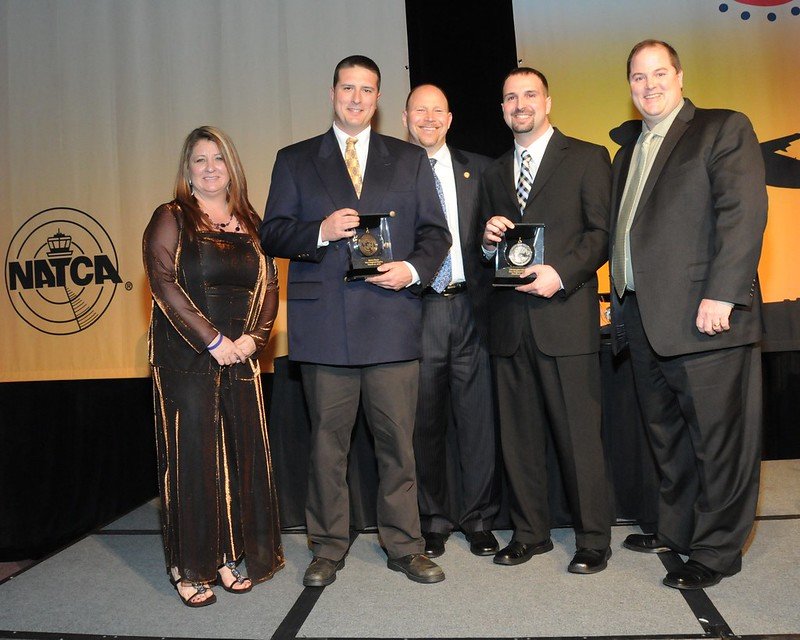
With daylight waning, and an aircraft stuck amidst rapidly deteriorating weather conditions and mountainous terrain, timing is everything. And on Oct. 9, 2009, it was up to controllers Kevin Plante and Christopher Presley to help the pilot of N5151L beat the clock.
N5151L’s pilot had just found himself in a tricky situation as he was quickly losing hundreds of feet of altitude while simultaneously unable to maintain a heading or constant speed; the seriousness of the situation clearly evident as controller Kevin Plante kept his eyes peeled to radar.
The aircraft initiated radio contact with Portland and advised it was VFR in IMC conditions with a transponder that didn’t work. Knowing only the last position of the aircraft as the mountainous area of Fryeburg Fair and receiving no radar return for this particular aircraft, Plante quickly scanned his scope to locate a primary radar return and, following the pilot’s description of “circling,” was then able to correlate the primary return to ultimately locate the aircraft.
Plante, aware that the pilot was suffering disorientations among the clouds, maintained continuous dialog in effort to calm the shaken pilot and made a suggestion for the pilot to land at Portland using a surveillance approach.
N5151L: It’s definitely an optical illusion up here.
Plante: Looks like we kinda have you doing circles out there. I just need to figure out a way to get you on a heading and have your wings level on that heading.
N5151L: I’m getting a little disoriented and losing altitude substantially.
A rated commercial pilot himself, Plante informed the pilot that there were two other commercially-rated pilots sitting in the radar room with to him in an effort to ease the shaken pilot. Reassuring phrases such as “We’ll get you through this” and “We’ll get you down no problem” were voiced to the pilot as he worked to get himself oriented with the current surroundings.
During one loss of altitude the pilot broke out below the cloud deck and was able to spot landmarks around the town of Windham. Controller Chris Presley, who had already terminated his flight data training and handed off other aircraft in order to assist Plante, immediately grabbed a road map off the shelf to help his friend guide the pilot to Portland. Using several interstate highways, as well as pointing out lakes and various towns along the way, Presley relayed the directions through Plante until the runway approach lights were visible in the distance.
Through Plante’s composure, patience and pilot experience, and Presley’s quick-thinking initiative and dedicated assistance, N5151L made it in right before the big storm – a goal undoubtedly achieved through a team successfully unifying towards a common goal. The skilled efforts of these two controllers transformed a complex situation consisting of various risky circumstances into one of a safe and happy ending.
VIDEO: View award presentation here.
Read a transcript of event highlights.
Northwest Mountain Region: Troy Decker, Salt Lake Center
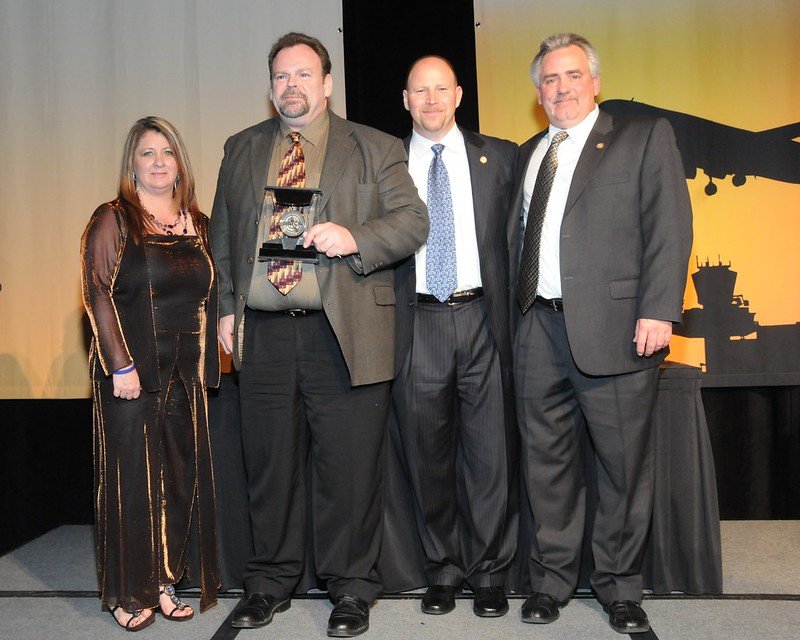
One of the trends we have seen in the six years of our NATCA Archie League Medal of Safety awards program has been the prevalence of winning flight assists that involved a controller who also had some level of flying experience. Whether a few lessons or many years in the cockpit, those controllers have added something very valuable to their array of skills that come in handy during an emergency situation in their airspace.
The latest chapter was written on March 29, 2009, when Marcus Plessner saw the misfortune of encountering engine trouble with his Piper Aztec above western Montana turn into great fortune when he flew into Sector 6 at Salt Lake Center, staffed at that moment by 23-year veteran controller and accomplished pilot Troy Decker.
N404CH: Yes sir, we’re having some problems with our number two engine, like to divert to nearest airport. Request vectors.
Plessner’s calm demeanor was matched by Decker, who quickly came up with a plan for the aircraft. The challenges were evident; a rough running engine and the plane’s location in a mountainous area where radar coverage is sketchy below 13,000 feet.
Decker: Four-zero-four charlie hotel, Anaconda Airport is just off your eleven o’clock and four miles. If you need information on it I can get you that or if you can make Butte. Butte is about… just picked you up on radar sir, radar contact. One-five miles northwest of (inaudible) approximately Butte Airport eleven o’clock, two-zero miles.
Plessner accepted the idea of Butte and began a descent to get an approach. Decker gave him a detailed weather report and it quickly became apparent that Butte was perhaps not the best option as the weather was reported below minimums in the area. At that point, the situation with Plessner’s engine worsened and he formally declared an emergency. Decker quickly provided other options as landing alternatives, starting with Anaconda, then Dillon where the weather seemed a bit better.
“Troy does an excellent job relaying information so the pilot could make an informed decision as to which airport he should choose,” Salt Lake Center Facility Representative Doug Pincock said.
As Plessner’s number two engine went out completely, Decker gave him another complete weather and situation briefing and instructed him to descend and maintain an altitude of 12,000 feet. Decker threw out Missoula as another option.
N404CH: Yeah. How’s Missoula’s weather? Uh, we got smoke coming off our number two right now, four charlie hotel.
Decker: Okay, uh, Missoula is two-one-one-seven special. Winds three-two-zero at one-zero. Visibility one and one quarter. Light snow. Mist. Ceiling seven hundred overcast. Temperature one. Dew point zero. Altimeter two niner six niner.
N404CH: Alright, let’s go for Missoula. Our number two is on fire at this time for four charlie hotel.
Decker told Plessner that Anaconda Airport was actually right behind him, albeit plagued by more weather problems. Plessner said he wanted it and Decker told him it was a VOR approach. But just as quickly as that option came, it went with the realization that Butte was, in fact, going to be the best final option. Decker provided updated information and recommended an alternate approach to expedite the landing.
Decker: November four-zero-four charlie hotel, alright sir. Anything else I can get for you right now? No NOTAMS affecting you. Any runway you want, of course. It’s just the weather we’re looking at sir.
N404CH: Alright, sounds good. Understand it is a weather issue. We are VOR Runway one-five and we do request crash fire and rescue assistance when we get there please.
Decker: They’re on the way sir.
N404CH: Alright, Salt Lake Center Aztec four-zero-four charlie hotel we are barely legal VFR. We got the airport. We are in the ILS to Runway one-five at this time.
Decker then provided one last instruction, which was to give them a call at the center when things settled down. A safe landing ensued.
“Troy is an accomplished pilot himself and IFR rated and that experience proved invaluable,” Pincock said. “He was able to anticipate the pilot’s needs and used personal knowledge of the area to help produce a favorable outcome to an otherwise dire situation.”
VIDEO: View award presentation.
Read transcript of event highlights.
Southern Region: Jessica Anaya, Lisa Grimm, Nathan Henkels, Miami Center; Dan Favio, Brian Norton, Carey Meadows, Fort Myers ATCT
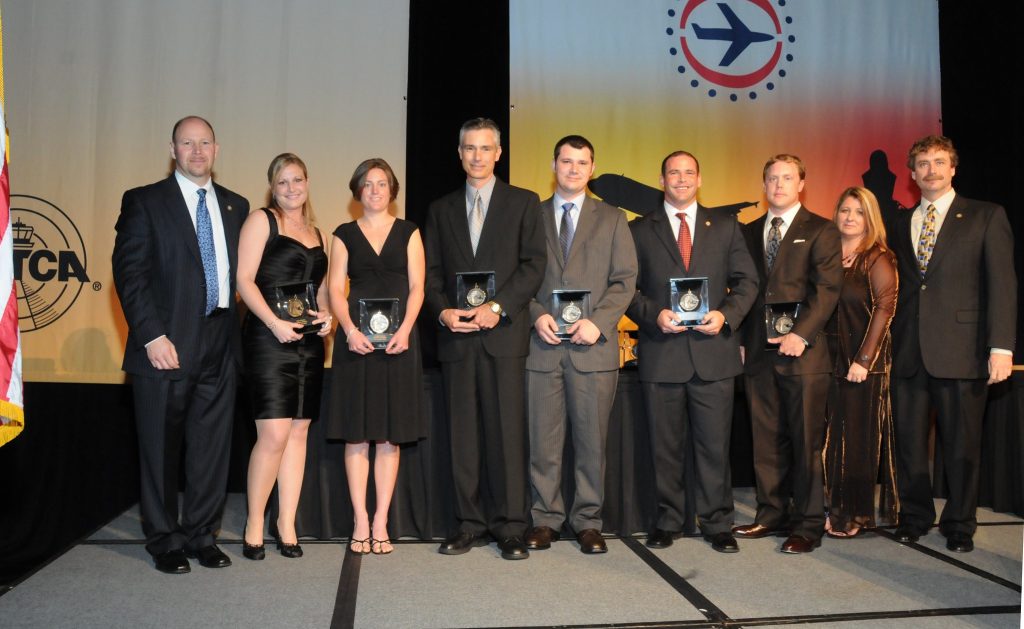
“I’ve gotta’ declare an emergency. My pilot’s…unconscious. I need help up here.”
These stirring words hung heavy in the air as Doug White, passenger of the King Air aircraft, reached out for help – help from anyone that could provide it on this busy Easter Sunday.
“My pilot’s deceased… I need help.”
While his wife and two daughters looked on in shock, White took over the cockpit as various Miami controllers began to lighten the load of Nathan Henkels and Lisa Grimm who immediately made moves to assist the troubled passenger.
Though a private pilot, White had never flown a larger, two-engine King Air and was now in a life-threatening situation as the plane hit 5,000 feet and continued climbing.
As Jessica Anaya stepped in to coordinate the rerouting of all aircraft in this high traffic area of Southern Florida, Grimm worked to calmly explain the specifics of the aircraft to White as he frantically sought to turn off the autopilot.
“Number five delta whiskey, disengage the autopilot. We’re gonna have you hand fly the plane,” she instructed. “Hold the yoke level and disengage the autopilot.”
“Alright, I disengaged it,” stated White, surprisingly composed as he was forced to take action in order to stop the climb. “I’m flyin’ the airplane by hand.” And, in his typical light-hearted demeanor that seems to find humor in any situation, followed it up with a request for Grimm to find the longest, widest runway she could.
“You doin’ alright there descending?” Grimm asked a few minutes later, as she did repeatedly throughout the event. “I felt as long as he had some reassurance, he had enough skills to successfully manipulate the controls and bring the plane down,” recalls Grimm of her actions that day.
“Oh, we’re havin’ a hoot, niner delta whiskey,” White responded in his thick southern drawl.
He lay in the hands of a team that had quickly formed an assembly line formation in order to successfully alternate between transferring control on the radio channel, advising the passenger, and issuing control instructions to other aircraft. Through the pilot experience so patiently displayed by Grimm and the hard work of Henkels and Anaya, White was able to get the plane in the appropriate position to steer towards Ft. Myers Airport where Dan Favio, Brian Norton, and Carey Meadows were waiting to take over.
It was at this point that Favio called up good friend and veteran pilot Kari Sorenson of Danbury, Conn., for help in talking White down. Also a flight instructor, Sorenson was able to relay important details via cell phone regarding the positions of controls, switches, and how to configure the King Air for landing. Favio and Norton, set up on a single scope and a separated frequency to allow for complete focus, received the instructions from Sorenson which they carefully echoed to White. With a successful touchdown finally completed, the two handed the aircraft off to Meadows at ground control where he proceeded to assist White with shutdown instructions.
With one unfortunate and unpreventable death, came the incredible saving of four others thanks to those who worked the skies that Easter Sunday. The teamwork was unmistakable as the experience and calm composure of the controllers in Miami joined forces with the quick-thinking skills of the Fort Myers team. Enhanced by the unforgettable courage displayed by Doug White through these adverse circumstances, the ATC system worked together from tower to center, from pilot to passenger, to bring a successful end to this unexpected and traumatic event that could have easily gone from bad to worse.
“The husbands and the wives of air traffic controllers have no idea what their spouses do for a living,” said White after the fact. “When something good happens, air traffic controllers don’t get the high-fives and the ‘attaboys.’ I’m going to give them the ‘attaboy.’”
View transcript of event highlights.
Below: View the video of the award presentation.
Southwest Region: Natasha Hodge and Douglas Wynkoop, Dallas-Fort Worth TRACON
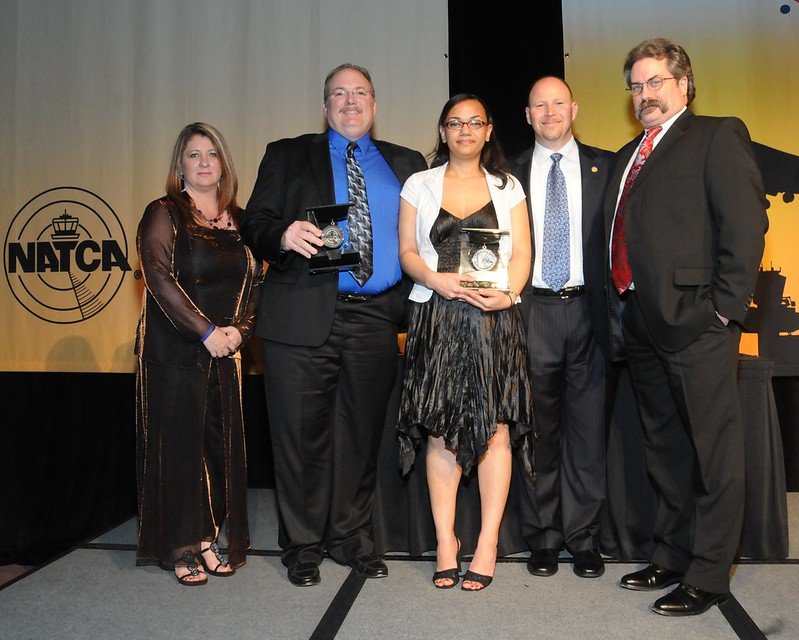
“Sometimes in life, we don’t always get to thank our benefactors,” wrote pilot Scott Spencer in a letter to D10 TRACON.
Thanks to the actions of Douglas Wynkoop and Natasha Hodge, Scott Spencer was able to do just this.
One a VRA developmental, one a 27-year veteran – both proved skill and resolve beyond measure with the terrific work they displayed on Dec. 7, 2009, when faced with a confused and disoriented experimental aircraft in distress.
Natasha Hodge was working her certification ride on this particular evening when N300SX on an instrument flight plan checked onto frequency inbound to Fort Worth Meacham Airport. Hodge watched carefully as the aircraft went from an assigned altitude of 3,000 on a heading of 315, to 1,700 feet on a heading of 065 in just 24 seconds.
Witnessing the drastic flight loops taking place in front of her, she again calmly instructed the aircraft to the assigned altitude, but this time, the aircraft continued to climb to as high as 5,200 feet.
Hodge: Are you having any difficulties?
N300SX: I had a little problem with my, uh, GPS on the approach.
Now with the specific problem defined, Hodge assigned headings for an ILS approach. The cloud ceiling of 600 feet overcast and the visibility of half a mile precluded anything but an instrument approach. Once again, however, she was forced to redirect the aircraft due to the pilot’s series of erratic turns and difficulty tracking the localizer.
Hodge: You’re way below the glide scope… the localizer two thousand five hundred down there at Cowtown. Climb and maintain three thousand. Cancel approach clearance. Fly present heading.
Persistent to try one more time, Hodge issued no-gyro vectors to final.
N300SX: We’re… we’re in trouble. It’s, uh, losin’ power.
“Jet Speed thirty-five, turn left heading three-six-zero immediately,” Hodge promptly advised over frequency to a nearby aircraft as she continued to work the sector in addition to assisting the experimental aircraft.
Witnessing the extensive length of time Hodge had spent thus far assisting the aircraft and taking into account the rapidly-intensifying situation, Douglas Wynkoop stepped in to take over the situation. He immediately redirected other aircraft in the area while, at the same time, turning the distressed aircraft away from an antennae which now lay in its path of descent. The aircraft was able to regain power and, after witnessing the previous three missed approaches and knowing there was less than 40 minutes of fuel with no airports reporting VFR conditions within the limit of flying time, Wynkoop suggested an ASR approach into Navy Fort Worth after exhausting all other options. With the excellent assistance of the GCA controllers at Navy Fort Worth, the ASR approach and landing was successful.
During his communication throughout the event, Wynkoop made sure he was clear on the pilot’s intentions while patiently offering up multiple landing options for the aircraft. He professionally alerted the control tower regarding all emergency information, including pilot, aircraft and approach details, to ultimately ensure the aircraft’s safety upon descent.
Wynkoop not only stayed in tune with all aspects of the situation at hand, both on frequency and behind the scenes, but this seasoned veteran remained confident in his developmental for the majority of the emergency. He allowed her to excel at her job and prove herself capable of handling extreme pressure with composure and professionalism before then taking over.
Combined, these two members worked the aircraft for 51 minutes – 30 minutes of which consisted of critical circumstances requiring precise instruction – and demonstrated teamwork and commitment at its finest during the entire ordeal.
VIDEO: View award presentation.
Read transcript of event highlights.
Western Pacific Region: Ron Chappell, Southern California TRACON
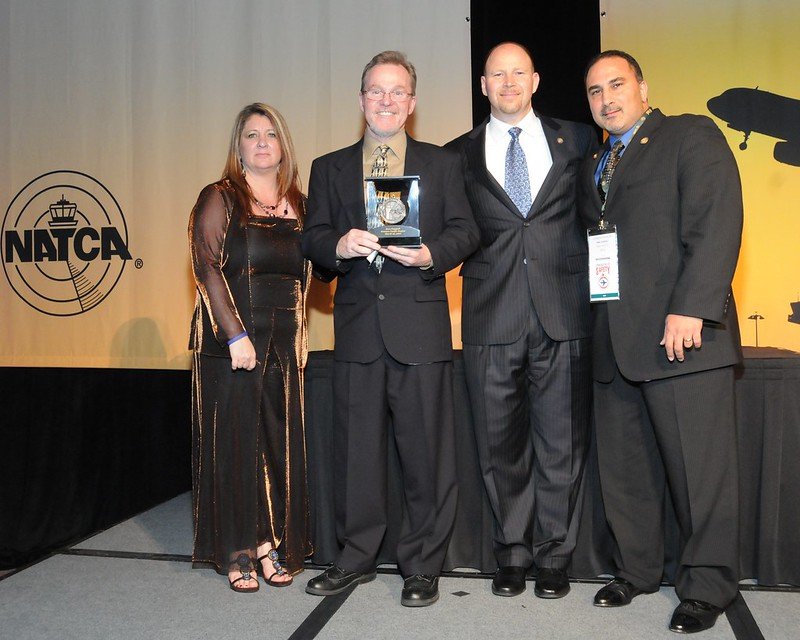
For 22-year veteran Southern California air traffic controller Ron Chappell, who knows pretty much everything there is to know about the ultra complex and intricately choreographed airspace around LAX, nothing goes unnoticed. That is especially true for a tiny blip of a primary radar target on Chappell’s scope at Southern California TRACON (SCT) that has errantly wandered unannounced and unmarked into the delicate dance of his perfectly crafted final approach lined up for Runway 25 Left.
Crystal clear days in the Los Angeles Basin provide a recipe for a traffic mix that includes general aviation aircraft flying without a transponder, along with high volume commercial aircraft. On this particular sunny day in June, Chappell was strapped into the Downey sector position (south finals into LAX).
While working, Chappell observed a primary-only target converging with SkyWest Airlines Flight 6522, a Bombardier Canadair regional jet, who was inbound on the 25-Left ILS.
Rarely do general aviation aircraft penetrate the Los Angeles Class Bravo airspace. But on this day, the Class B was penetrated by an aircraft (it turned out to be a Navion) who was simply not squawking a discreet code which would make him visible to ATC. That’s when Chappell – an experienced controller who knows how to pick up a small primary target and identify it as an aircraft and not a vehicle, sprang into quick action.
“SkyWest sixty-five twenty-two, traffic eleven o’clock and two miles westbound primary target, altitude unknown.”
The following transcript shows just how close the two aircraft came and the level of great communications needed to ensure a safe outcome.
SKW6522: He’s in sight, sixty-five twenty-two … uh … I can’t tell the type yet. I’ll tell ya in a second.
Chappell: Okay, is he, um, above you or below you?
SKW6522: Alright, uh, yeah, he’s, uh, pretty clueless. He’s a one, well, no, it’s an Avian and he was gonna run into us. We had to descend, sorry sir.
Chappell: SkyWest sixty-five twenty-two, glad I said something. I don’t have an altitude readout on him.
SKW6522: Well, um, we don’t have him on TCAS at all, so I don’t think he has a transponder.
Chappell: SkyWest sixty-five twenty-two, reduce speed to two-one-zero.
SKW6522: Bring down on the speed now sir, sixty-five twenty-two.
SKW6522: Just to verify the speed is two-ten, for sixty-five twenty-two.
Chappell: SkyWest sixty-five twenty-two affirmative.
Chappell: SkyWest sixty-five twenty-two, I just have to ask reference the paperwork, he was around eight thousand five hundred or so, somewhere about the time you had to descend?
SKW6522: Yeah, eight thousand or eight thousand five hundred, an um, it was definitely a Navion, um white. That’s about all I can tell you. It looked like maybe a brown top and, yeah, we had to descend. He had no TCAS. We didn’t get a resolution or anything but we had to descend to avoid him.
Chappell: SkyWest sixty-five twenty-two, we have a radar track on him and we will follow him as long as we can keep radar on him, and file the appropriate paperwork on him.
SKW6522: I just want to say we really appreciate the fact that you said something, cause we didn’t see him until you said something.
Chappell: You’re welcome. Glad to help.
Chappell began his FAA career in 1988 at Burbank Tower and moved over to the old LA TRACON in 1992. In 1994, the facility was consolidated into SCT and Chappell is now in his 16th year there. This honor marks Chappell’s second Archie League award. He and Al Hurst won the first Western Pacific Archie League award for a save in 2004 involving nearly the exact set of circumstances as this 2009 event: An unidentified VFR aircraft posing a traffic and safety hazard to a SkyWest flight inbound to LAX.
Veteran SCT controller Ron Geyer, who nominated Chappell for the 2009 save, said of the quick thinking, “As you can clearly hear on the tape, Ron’s awareness prevented a collision.”
VIDEO: View award presentation.
View a transcript of event highlights.
President’s Award: Jessica Anaya, Lisa Grimm, Nathan Henkels, Miami Center; Dan Favio, Brian Norton, Carey Meadows, Fort Myers ATCT
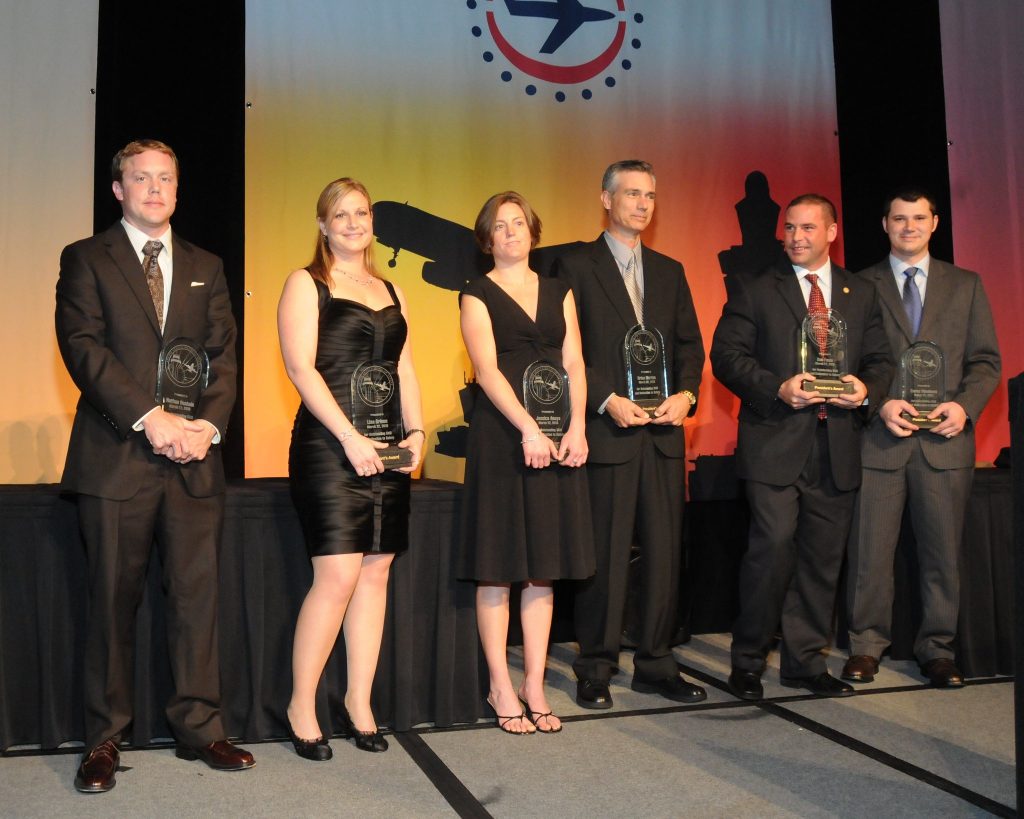
“I’ve gotta’ declare an emergency. My pilot’s…unconscious. I need help up here.”
These stirring words hung heavy in the air as Doug White, passenger of the King Air aircraft, reached out for help – help from anyone that could provide it on this busy Easter Sunday.
“My pilot’s deceased… I need help.”
While his wife and two daughters looked on in shock, White took over the cockpit as various Miami controllers began to lighten the load of Nathan Henkels and Lisa Grimm who immediately made moves to assist the troubled passenger.
Though a private pilot, White had never flown a larger, two-engine King Air and was now in a life-threatening situation as the plane hit 5,000 feet and continued climbing.
AUDIO: Miami Center Members Work With Doug White. Click here.
As Jessica Anaya stepped in to coordinate the rerouting of all aircraft in this high traffic area of Southern Florida, Grimm worked to calmly explain the specifics of the aircraft to White as he frantically sought to turn off the autopilot.
“Number five delta whiskey, disengage the autopilot. We’re gonna have you hand fly the plane,” she instructed. “Hold the yoke level and disengage the autopilot.”
“Alright, I disengaged it,” stated White, surprisingly composed as he was forced to take action in order to stop the climb. “I’m flyin’ the airplane by hand.” And, in his typical light-hearted demeanor that seems to find humor in any situation, followed it up with a request for Grimm to find the longest, widest runway she could.
“You doin’ alright there descending?” Grimm asked a few minutes later, as she did repeatedly throughout the event. “I felt as long as he had some reassurance, he had enough skills to successfully manipulate the controls and bring the plane down,” recalls Grimm of her actions that day.
“Oh, we’re havin’ a hoot, niner delta whiskey,” White responded in his thick southern drawl.
He lay in the hands of a team that had quickly formed an assembly line formation in order to successfully alternate between transferring control on the radio channel, advising the passenger, and issuing control instructions to other aircraft. Through the pilot experience so patiently displayed by Grimm and the hard work of Henkels and Anaya, White was able to get the plane in the appropriate position to steer towards Ft. Myers Airport where Dan Favio, Brian Norton, and Carey Meadows were waiting to take over.
It was at this point that Favio called up good friend and veteran pilot Kari Sorenson of Danbury, Conn., for help in talking White down. Also a flight instructor, Sorenson was able to relay important details via cell phone regarding the positions of controls, switches, and how to configure the King Air for landing. Favio and Norton, set up on a single scope and a separated frequency to allow for complete focus, received the instructions from Sorenson which they carefully echoed to White. With a successful touchdown finally completed, the two handed the aircraft off to Meadows at ground control where he proceeded to assist White with shutdown instructions.
AUDIO: Fort Myers Members Work With Doug White. Click here.
With one unfortunate and unpreventable death, came the incredible saving of four others thanks to those who worked the skies that Easter Sunday. The teamwork was unmistakable as the experience and calm composure of the controllers in Miami joined forces with the quick-thinking skills of the Fort Myers team. Enhanced by the unforgettable courage displayed by Doug White through these adverse circumstances, the ATC system worked together from tower to center, from pilot to passenger, to bring a successful end to this unexpected and traumatic event that could have easily gone from bad to worse.
“The husbands and the wives of air traffic controllers have no idea what their spouses do for a living,” said White after the fact. “When something good happens, air traffic controllers don’t get the high-fives and the ‘attaboys.’ I’m going to give them the ‘attaboy.’”
BELOW: Watch the President’s Award presentation. Joining the controllers on stage for the President’s Award with NATCA President Paul Rinaldi, Executive Vice President Trish Gilbert, and Southern Regional Vice President Victor Santore was Doug White. In this video below, White delivers emotional remarks in a riveting ceremony that captured one of the most dramatic events in the history of the Archie League Medal of Safety Awards, which NATCA began in 2005.
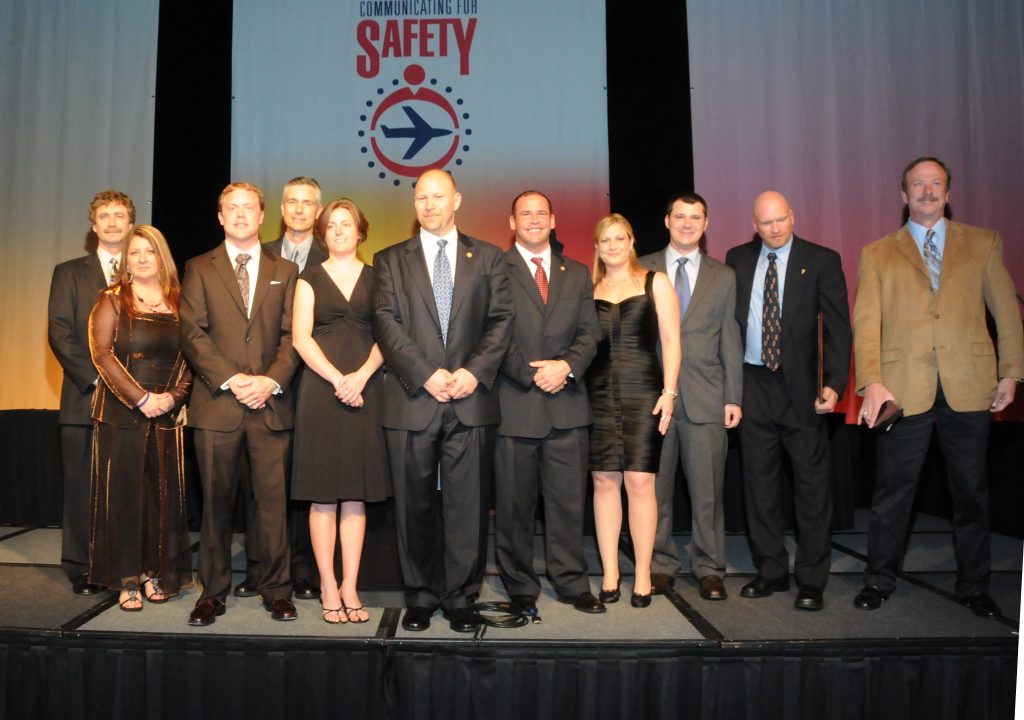
Honorable Mention
Alaskan Region
Alan Zelez, Anchorage TRACON
Marcus Tomlin & Christopher Roberts, Anchorage ATCT
Eastern Region
April Hedstrom, Mona Iddings, Bill Davenport & Mark Ulanch, Charleston, W. Va. ATCT
Lee Owens, Roanoke ATCT
Brian Buckley, Philadelphia ATCT
Jeffrey Weldon, Washington Center
Chad Bentz & John Blanco, Philadelphia ATCT
Patricia Harshman, Washington Center
Patrick Harten, New York TRACON; Bill McLoughlin, New York-LaGuardia ATCT
Great Lakes Region
Gregory Schmarr & Travis Stamper, Indianapolis Center
John Overman, Lansing ATCT
Lou Alvarez, Chicago Midway ATCT
Derrick Rogers, Chicago O’Hare TRACON
Marc Schneider & Wendy Schneider, Indianapolis Center
Leslie Snyder, Evansville
Jay Moffat, Chicago O’Hare ATCT
Dale Taylor, Indianapolis Center
New England Region
Nancy Yeomans, Boston Center
Northwest Mountain Region
Christopher Schenk, Duane Johnsen, Jim Ullmann & Robert Normandeau, Seattle Center
Alan Gorski, Michael Sutherland & Martin Hunter, Colorado Springs ATCT
Southern Region
Robert Hill, Sr. & Mark Boumenot, Fayetteville ATCT
Don Nikolich & David Pridgen, Memphis Center
Jonathan Graves, Orlando ATCT
Lynn Powers, Jacksonville Center
William Thompson, Jacksonville ATCT
Brandi Norberg & Lawrence Ghersi, Miami Center
Eric Stein & David Miller, West Palm Beach ATCT
Michael Minlschmidt, Asheville ATCT
Kendle Anspach, Miami Center
Southwest Region
Paul Seifert, Roswell ATCT
John Charlton, Lake Charles ATCT
Ronald Cecil & Anthony Ruffino, Houston Intercontinental ATCT
Joe Corder, Victoria ATCT
David “AU” Westbrook, Dallas/Fort Worth ATCT
Joseph E. Friend, Dallas/Fort Worth ATCT
Brian Haag, Houston Center
Larry Gardner, Dallas Addison ATCT
Western Pacific Region
Roger Giles, Southern California TRACON
David Clegg, Santa Barbara ATCT

